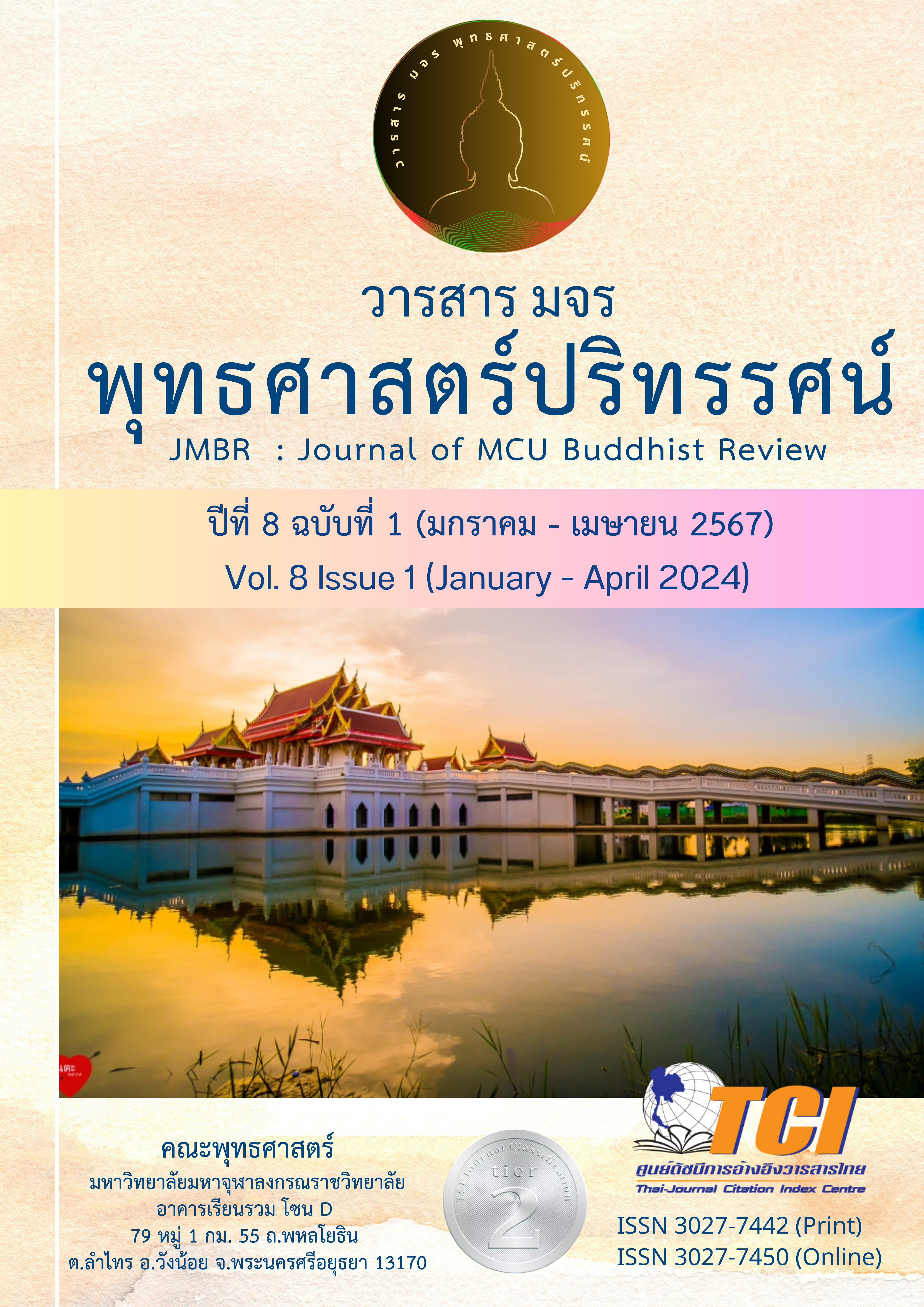พุทธวิธีการบริหารบุคคลของโรงเรียนมัธยมศึกษา สังกัดสำนักงานคณะกรรมการการศึกษาขั้นพื้นฐาน
Main Article Content
บทคัดย่อ
บทความวิจัยนี้มีวัตถุประสงค์เพื่อ 1) ศึกษาองค์ประกอบพุทธวิธีการบริหารบุคคล 2) พัฒนารูปแบบพุทธวิธีการบริหารบุคคล และ 3) ประเมินรูปแบบพุทธวิธีการบริหารบุคคล การวิจัยนี้เป็นการวิจัยแบบผสานวิธี แบ่งเป็น 3 ระยะ ดังนี้ 1) การวิเคราะห์องค์ประกอบ ผู้ให้ข้อมูล ได้แก่ ผู้อำนวยการโรงเรียน และนักวิชาการ จำนวน 9 คน เก็บรวบรวมข้อมูลโดยการสัมภาษณ์ วิเคราะห์ข้อมูลโดยการวิเคราะห์เนื้อหา และการยืนยันองค์ประกอบ กลุ่มตัวอย่างในการตอบแบบสอบถาม คือ ผู้อำนวยการโรงเรียนมัธยมศึกษา สังกัดสำนักงานคณะกรรมการการศึกษาขั้นพื้นฐานในภาคกลาง จำนวน 520 คน เก็บรวบรวมข้อมูลโดยการสอบถาม วิเคราะห์ข้อมูลโดยหาความถี่ ร้อยละ ค่าเฉลี่ย ส่วนเบี่ยงเบนมาตรฐาน และการวิเคราะห์องค์ประกอบเชิงยืนยัน 2) การพัฒนารูปแบบ โดยนำผลการศึกษาจากระยะที่ 1 มาพัฒนารูปแบบ และ 3) การประเมินรูปแบบ โดยการสัมมนาอิงกลุ่มผู้เชี่ยวชาญ ประกอบด้วย ผู้เชี่ยวชาญด้านบริหารการศึกษา บริหารสถานศึกษาพุทธวิธีการบริหารบุคคล และพระพุทธศาสนา จำนวน 9 คน วิเคราะห์ข้อมูลโดยการวิเคราะห์เนื้อหา ส่วนการนำรูปแบบไปปฏิบัติในโรงเรียน จำนวน 1 แห่ง ผู้ให้ข้อมูล ได้แก่ ผู้อำนวยการโรงเรียน รองผู้อำนวยการโรงเรียน และครูในกลุ่มบริหารงานบุคคล จำนวน 3 คน เก็บรวบรวมข้อมูลโดยการประชุมสะท้อนผลการปฏิบัติ วิเคราะห์ข้อมูลโดยการวิเคราะห์เนื้อหา
ผลการวิจัย พบว่า 1) องค์ประกอบพุทธวิธีการบริหารบุคคล ประกอบด้วย (1) การสรรหาให้ตรงตามคุณสมบัติ (2) การธำรงรักษาไว้พัฒนางาน (3) การพัฒนาผ่านฐานสมรรถนะในตน และ (4) การสำเร็จของงานอย่างมีคุณค่า 2) รูปแบบพุทธวิธีการบริหารบุคคล ประกอบด้วย (1) ส่วนนำ ได้แก่ หลักการ วัตถุประสงค์ เป้าหมาย (2) ส่วนสำคัญ ได้แก่ องค์ประกอบพุทธวิธีการบริหารบุคคล และ (3) ส่วนการนำไปปฏิบัติ ได้แก่ ขั้นตอน กิจกรรม เครื่องมือการบริหาร 3) ผู้เชี่ยวชาญมีฉันทามติให้รูปแบบพุทธวิธีการบริหารบุคคลมีความถูกต้อง เหมาะสม เป็นไปได้ และเป็นประโยชน์ และผลการนำรูปแบบด้านการพัฒนาผ่านฐานสมรรถนะในตนไปปฏิบัติในโรงเรียน พบว่า (1) โรงเรียนมีการวางแผนการพัฒนาบุคลากรตามระดับสมรรถนะ (2) กำหนดวิธีการพัฒนาบุคลากรด้วยหลักโยนิโสมนสิการ (3) จัดการฝึกอบรมเพื่อพัฒนาสมรรถนะในตนโดยยึดหลักไตรสิกขาด้านการรักษาวินัย ด้านคุณธรรม และด้านความรู้จริงในศาสตร์ที่จำเป็นของวิชาชีพครู และ (4) พัฒนาส่งเสริมให้บุคลากรมีความเชี่ยวชาญในงาน
Article Details

อนุญาตภายใต้เงื่อนไข Creative Commons Attribution-NonCommercial-NoDerivatives 4.0 International License.
- บทความที่ได้รับการตีพิมพ์เป็นลิขสิทธิ์ของวารสาร มจร พุทธศาสตร์ปริทรรศน์
- ข้อความใดๆ ที่ปรากฎในบทความที่ได้รับการตีพิมพ์ในวารสาร ถือเป็นความรับผิดชอบของผู้เขียนบทความ และข้อคิดเห็นนั้นไม่ถือว่าเป็นทัศนะและความรับผิดชอบของกองบรรณาธิการวารสาร มจร พุทธศาสตร์ปริทรรศน์
เอกสารอ้างอิง
ชินชัย แก้วเรือน. (2558). การบูรณาการการครองใจคนตามแนวทางพระพุทธศาสนา. พิฆเนศวร์สาร. 11(2), 154-168.
ทวีศักดิ์ สมนอก. (2562). การพัฒนารูปแบบการบริหารโรงเรียนที่มีประสิทธิผลโดยใช้โรงเรียนเป็นฐานของโรงเรียนในสังกัดสำนักงานเขตพื้นที่การศึกษามัธยมศึกษา เขต 25. วิทยานิพนธ์ครุศาสตรดุษฎีบัณฑิต บัณฑิตวิทยาลัย: มหาวิทยาลัยราชภัฏมหาสารคาม.
พระมหากิจการ โชติปญฺโญ. (2558). การบริหารบุคคลตามหลักธรรมทางพระพุทธศาสนา. วารสาร บัณฑิตศาสน์. 13(2), 45-48.
พระมหาธฤติ รุ่งชัยวิทูร. (2558). การพัฒนาประสิทธิภาพการทำงานเชิงพุทธ. สยามวิชาการ. 15(25), 80-93.
พระมหาสุขสันติ์ สุขวฑฺฒโน. (2558). การศึกษาพระพุทธศาสนาในจารึกสมัยสุโขทัย. วารสารวิชาการมหาวิทยาลัยราชภัฏพระนคร. 6(2), 62-76.
พูลพงศ์ สุขสว่าง. (2556). โมเดลสมการโครงสร้าง. กรุงเทพฯ: วัฒนาพานิช.
วรากฤต เถื่อนช้าง. (2557). รูปแบบการบริหารบุคคลเชิงพุทธของวิทยาลัยสงฆ์ในกลุ่มภาคเหนือ. นครสวรรค์: วิทยาลัยสงฆ์ มหาวิทยาลัยมหาจุฬาลงกรณ์ราชวิทยาลัย.
สำนักงานคณะกรรมการพัฒนาระบบราชการ. (2552). คู่มือการจัดระดับการกำกับดูแลองค์การภาครัฐตามหลักธรรมาภิบาลของการบริหารกิจการบ้านเมืองที่ดี (Good Governance Rating). กรุงเทพฯ: พรีเมียร์ โปร์.
สำนักงานคณะกรรมการการศึกษาขั้นพื้นฐาน. (2556). คู่มือการบริหารโรงเรียนในโครงการพัฒนาการบริหารรูปแบบบุคคล. กรุงเทพฯ: ชุมนุมสหกรณ์การเกษตรแห่งประเทศไทย.
เอกลักษณ์ เพ็งพรหม. (2565). รูปแบบการบริหารบุคคลตามหลักธรรมในพุทธศาสนาของมหาวิทยาลัยสงฆ์. วารสารพุทธมัคค์ศูนย์จริยธรรมศึกษาสำนักเรียนวัดอาวุธวิกสิตาราม. 7(1), 193-202.
School of Distance Education Bharathiar University, Coimbatore. (2008). Personnel Management Concepts. New Delhi: Excell Books Private.


